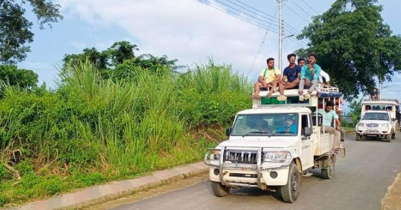Eye News Desk
Conquering thyself: A solo climb of Mount Pisang

As an avid mountaineer and outdoor sports enthusiast, I have always been drawn to the thrill of climbing a Himalayan mountain alone, without any guide, porter, or a teammate.
It took me more than two years to gather the courage and finally, I set out for it. Located near a popular trekking route like Annapurna, the Pisang Peak (6,091m) seemed perfect for my solo expedition.
It took me about five days to arrange the permit and finalise all the last minute preparations. On 22 February, I boarded a bus to Besisahar (municipality in Nepal), and a day later, I made it to Dhikur Pokhari from where I trekked until Upper Pisang, only to be held back for two days by bad weather.
With all my gears and rations on me, the climb was a three-camp journey for me instead of the typical two. The first two camps were located at 13,900 ft and 15,500 ft above sea level respectively, and neither had a water source nearby.
It was difficult to collect water from the snow deposits on top of small shrubs and bushes. On the third day, I finally reached the summit camp, which was located at an elevation of 17,550 ft. This camp was located on the top of a ridge, providing breathtaking views of Annapurna I.
From the summit camp, it usually takes about seven to eight hours to reach the summit with proper Sherpa support. Since I was climbing solo, I planned to start very early in the night but ended up starting at 7am.
After about 30 minutes of climbing, as I stood at the base of a long vertical rock climbing pitch, I realised how foolishly I had underestimated this route.
I was faced with multiple straight-up climbing pitches of approximately 70 to 90 degree in gradient, about 600 metres in total, with loose rocks all around. I lost a helmet and an action camera with lots of footage while climbing this section.
Finishing the whole route without fixed ropes or belay, I reached the snow portion of the climb by 2:30pm. Assessing the risks involved in reaching the summit and returning to the camp safely, I had to abandon the summit push (the last ascent before reaching the peak) and start climbing down.
I had reached a height of 6,061 metres on that push, which was only 30 metres shy of the actual summit in elevation.
When I returned to the camp, I was completely drained and could only manage to have a glass of water before sleeping till 3am. The next morning, my only struggle was overcoming the fact that I would have to climb that 700 metres and more all over again to reach the summit.
After a whole day of debating with myself and getting a weather update over my SAT (satellite) phone, I finally decided to go on a second push.
On the second summit push, I still could not manage to start early in the night due to extremely low temperature, around -24 degrees. It was a mental struggle to even step outside.
But I was relatively faster during the climb since I already knew the route. I advanced towards the summit point and found three different points to the summit, but no prayer flags since the snow deposit from winter was still there, waiting to melt.
The GPS marking I had with me was pointing to the last peak among the three as the summit point. I was getting an elevation reading of 6,096 metres. At about 3pm on 4 March, I finally reached the summit of Pisang Peak, which to my knowledge, may be the first successful solo climb on a six-thousander mountain from Bangladesh.
As I stood atop the summit, I knew I had to hurry down as soon as possible. I knew about a storm that was going to hit after 12pm and the region was already enveloped in a whiteout (a dense blizzard).
I began to descend as fast as I could. A light snow shower had already started an hour before; I was actually lucky to have the weather window until 3pm.
However, my luck was short-lived as I got caught in a snowstorm, and quite a fierce one. The wind speed was dangerously high. I could barely see the route as the snowflakes were directly hitting my face.
There was no track left either, and I couldn't even rely on my GPS as it only works with my phone, and I couldn't risk taking my hands out in that extreme cold to unlock it.
After struggling for three long hours alone in that life-threatening storm, I finally reached my camp at about 6:30pm, exhausted but relieved. It was a sweet sight when I first saw my tent from a distance.
I actually feared losing it to the storm as it was too windy for my cheap tent with fibre poles. I quickly made my way into it, feeling grateful for the warmth of the sleeping bag.
The next day, I started my descent towards Pisang village. I began descending at 12pm and reached the lodge by 9pm. By 10pm, I was enjoying a warm Nepalese thali of lentils and rice.
Looking back, I realise the climb was easier than the obstacles I faced before and after it, such as losing my passport and money, facing climbing permit frauds etc. Despite everything, the memories of this climb are going to stay with me for as long as I live.
Read More
- The heavenly beauty of Bandarban
- 4 places to visit in Tangail
- Bandarban tour with my mother on Eid vacation
- Tanguar Haor : striking beauty of water and hills
- Maldives tops the list of honeymoon destinations
- You can visit 135 countries in one ship, know the cost
- Explore Maldives with US-Bangla at low cost
- These five countries have no any airport!
- Trekking in the Himalayas is not permitted without a guide
- Nepali climber makes record 27th Everest summit
































